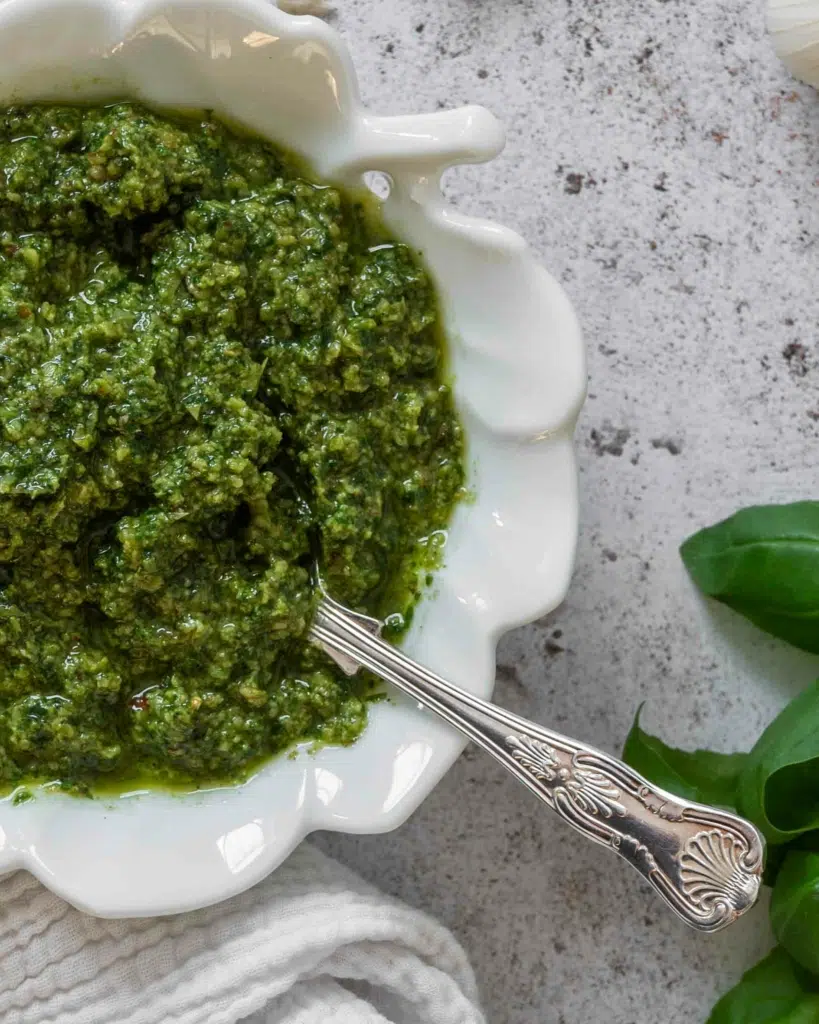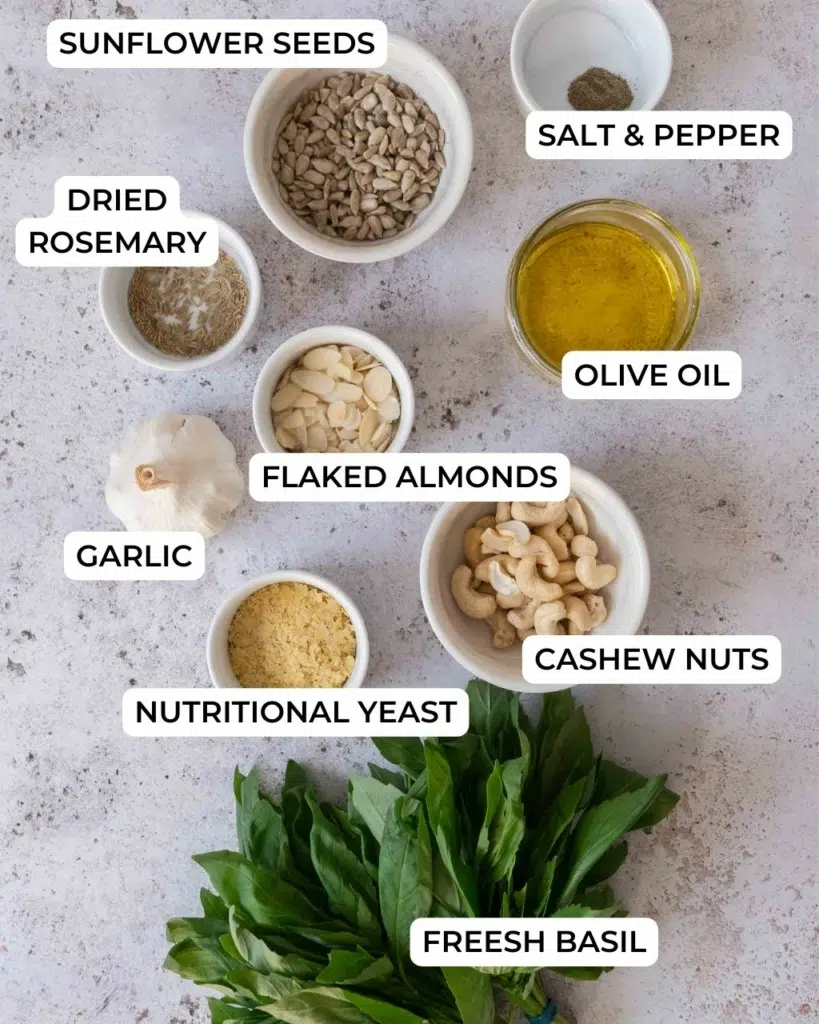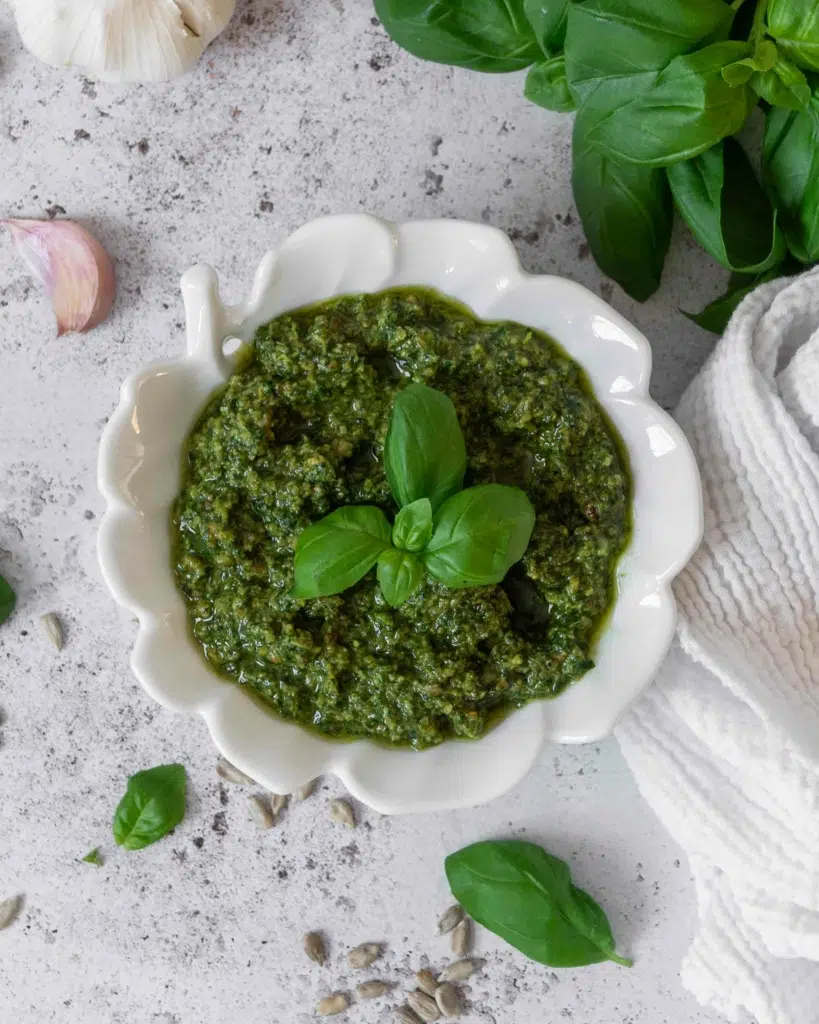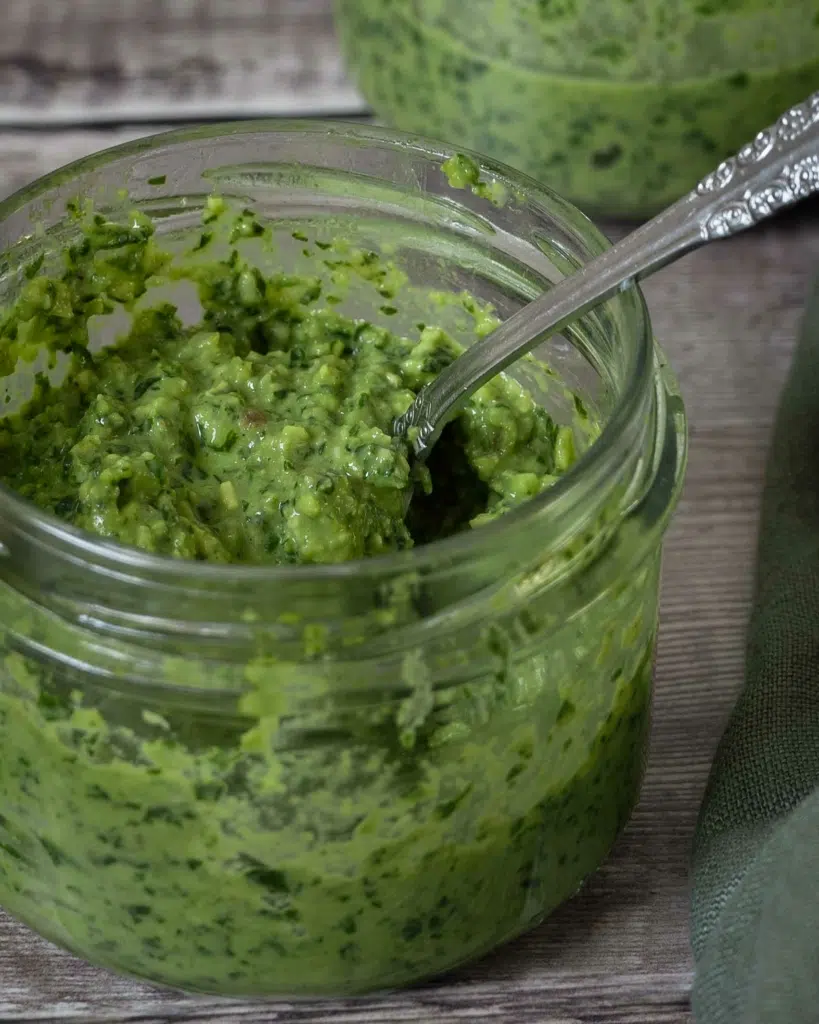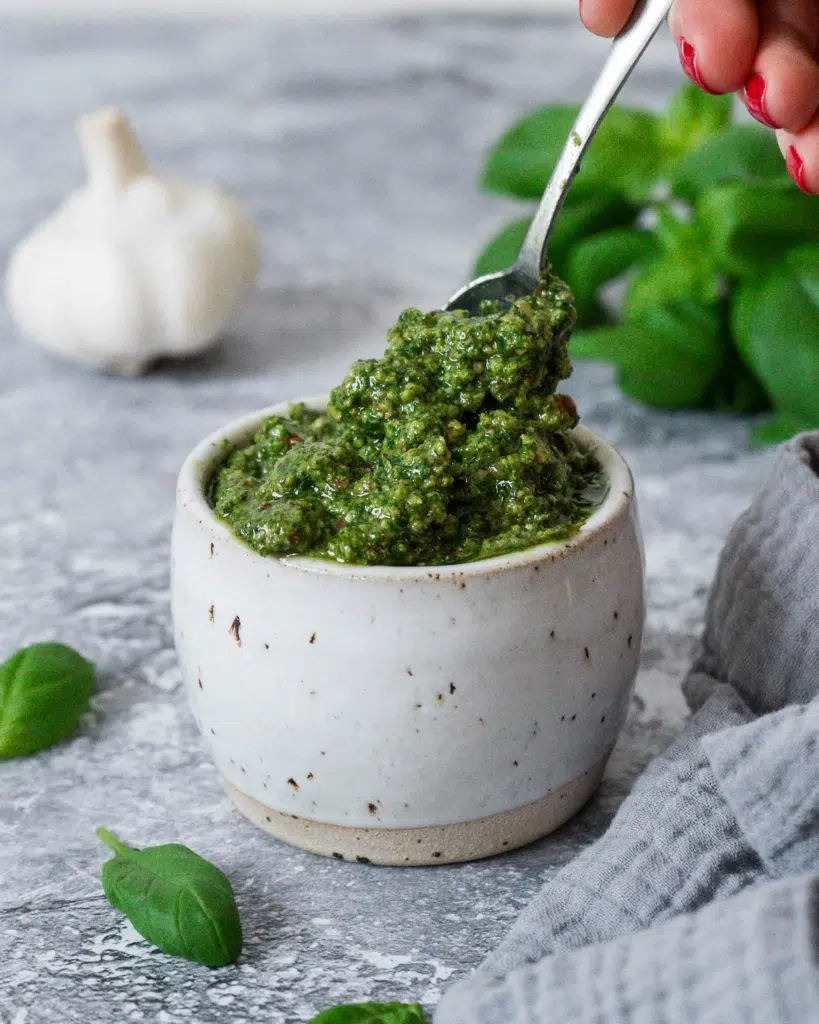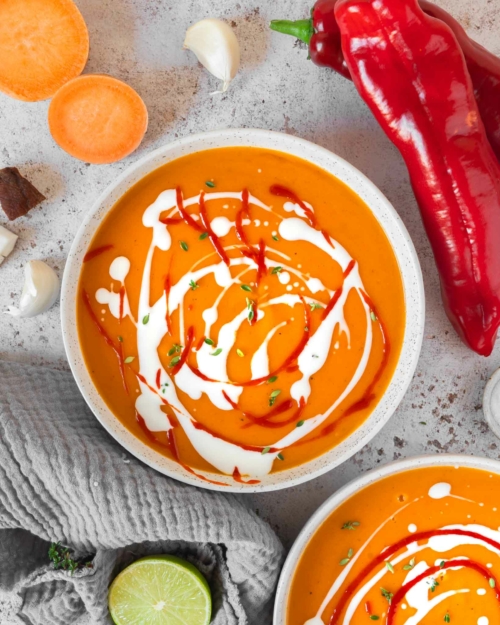When you buy through our links, we may earn a commission. Learn more.
Pesto doesn’t always have to include pine nuts! In this recipe for homemade pesto without pine nuts, we harness the flavour and texture of toasted sunflower seeds and cashews to create a flavoursome, nutty pesto in just 5 minutes (it’s also vegan!).
Pesto can easily be customised to suit your taste preferences, and omitting pine nuts is no exception. The trick is to find the right combination of ingredients to replicate the nutty flavour and creamy texture of a classic pesto and we think we’ve done just that!
This homemade pesto without pine nuts is packed with flavour; merging fresh herbs, nutty flavours and saltiness into a deliciously versatile sauce. We’ve even got a secret ingredient up our sleeve that replicates the woody flavour of pine nuts… giving you easy vegan pesto, without a pine nut in sight!
Quick Links:
- The written recipe
- The video recipe
- Success tips
- Step by step instructions
- What can you eat with pesto?
- FAQs
- Other flavoursome pesto recipes like this one
Did you know?
We’ve got a range of vegan, dairy-free pesto recipes available to suit the ingredients that you have on hand:
If you’re looking for a vegan pesto without nuts AND without pine nuts, take a look at our Nut-Free Pesto recipe, which shows you how to omit both tree nuts and pine nuts.
What is Pesto?
Traditional basil pesto is an Italian sauce made from fresh basil, garlic, pine nuts, parmesan cheese (or pecorino romano) and olive oil, that has become popular around the world. It’s got a bright green colour and fresh, herby flavour with an addictive saltiness that pumps flavour into many savoury dishes.
Pesto is believed to have originated from the port of Genoa in the Liguria region of Northern Italy.
Success Tips
Store-bought pesto tends to lack the vibrancy and freshness you get from a homemade pesto. Here are our top tips for making a flavoursome homemade vegan pesto without pine nuts:
- Use high quality ingredients. The predominant flavours in pesto come from the basil and olive oil so opt for fresh basil and a good quality extra-virgin olive oil to give you the best flavour. If you’ve got an abundance of fresh basil in the garden this summer, make a batch of homemade pesto and freeze it into portions to use over the coming months.
- Toast the seeds and nuts. In this homemade pesto recipe without pinenuts we use a combination of sunflower seeds, cashew nuts and flaked almonds to replicate the nutty, creamy flavours and textures of pesto. To bring out the best flavour, we recommend using toasted seeds and nuts. If your local grocery store does not sell a toasted variety, you can easily toast them at home by following the instructions on the recipe card below.
- Add a sprinkle of dried rosemary. We add a touch of dried rosemary to this pesto to replicate the delicate, earthy flavour that pine nuts carry.
- How to store delicious homemade pesto sauce:
- In the refrigerator. Place leftover pesto in an air-tight container. Add a thin layer of olive oil on top, or add a layer of eco-cling film (with the film touching the top of the pesto), before adding the lid. This helps to prevent the pesto from losing it’s green colour.
- In the freezer. To freeze pesto, add it to ice cube trays and then pop it in the freezer. Once frozen, decant the cubes into an airtight container or freezer bag.
How to make this Homemade Pesto Without Pine Nuts
Ingredients
Head to the recipe card at the bottom of this post for the complete list of ingredients including measurements.
Sunflower seeds, cashew nuts and flaked almonds – toasted is a must for flavour.
Fresh basil leaves
Nutritional yeast – the secret ingredient used to add a dairy-free cheesy flavour
Olive oil – ideally extra virgin
Garlic – opt for fresh garlic cloves if possible
Dried rosemary – to add a delicate earthy flavour
Seasoning – sea salt and black pepper
Water – used to thin the pesto
Equipment
You’ll need a food processor for this recipe, along with a small frying pan for toasting the nuts and seeds if they are not already pre-toasted.
Steps
Make sure to head to the recipe card at the bottom of this post for the full recipe and instructions! Here are the easy steps to make this simple vegan pesto recipe without pinenuts:
Gather together your ingredients.
Add the toasted seeds and nuts to the bowl of a food processor along with all of the other ingredients and pulse until smooth and combined. Scrape down the sides of the processor bowl and pulse again as necessary.
Tip: If your nuts and seeds are not already toasted, add them to a dry frying pan (no oil) and toast them over low heat until they are lightly golden. This will take around 10 minutes.
Tip: Sunflower seeds can take longer to break down than pine nuts. Process for long enough to create a smooth pesto.
Store the pesto in the refrigerator in an airtight container for up to 3 days. To preserve the colour as best as possible, cover the pesto with a thin layer of olive oil or eco cling film (with the film touching the top of the pesto) before adding an airtight lid.
Alternatively, you can freeze the pesto into ice cube trays to create single-serve portions that will last for 2 months in the freezer.
What can you eat with this Homemade Pesto Without Pine Nuts?
Here are some ways you can enjoy this vegan pesto without pine nuts:
- In pasta sauce. Pesto pasta is a classic – just stir a tablespoon or two of pesto through cooked, drained pasta until warm and you’ve got yourself an easy weeknight meal. Alternatively, stir pesto into your favourite pasta sauce – it will go particularly well with a vegetable and tomato sauce.
- What about pesto pizza? Make a batch of our Easy Vegan Pizza Dough and top it with pesto, vegan cheese and roasted vegetables for a delicious and colourful meal for the whole family.
- In sandwiches and wraps. Pesto goes well with many sandwich fillings; liven up your lunchbox with a vegan cheese and pesto sandwich or a meat free chicken and pesto wrap.
- Brighten up your summer salad. Pesto is such a flavoursome sauce that it can add a real vibrancy to summer salads as a salad dressing.
- Drizzle over soup. Add a zing of flavour and saltiness to your veggie soup by adding a swirl of pesto to the top.
- Pan fried tomato, rocket and pesto ciabatta anyone? Such a simple combination that tastes DIVINE! Cut open a ciabatta, brush it with olive oil and place it face down in a frying pan along with some halved cherry tomatoes. Fry until the ciabatta is golden and the cherry tomatoes have softened and then serve the ciabatta topped with rocket (arugula), tomatoes and pesto.
FAQs
What can I use instead of pine nuts in pesto?
To create our recipe for pesto without pine nuts we’ve used a blend of toasted sunflower seeds, cashew nuts and flaked almonds with a little pinch of rosemary for flavour.
Pesto is such a versatile sauce that you can use many different nuts and seeds to create it. We hope you enjoy this version! Try our other vegan pesto versions – classic vegan pesto, nut free pesto, almond pesto and walnut pesto.
What nut is closest to pine nut?
Pine nut is a relatively soft, creamy seed* therefore we’ve used cashew nuts as a base for our recipe for pesto without pine nuts, given their creamy taste and relatively soft texture. Macadamia nuts could also work well.
* Despite the name, pine nuts are the edible seeds of the pine tree (Allergy UK)!
How long does pesto last?
This homemade pesto without pine nuts can be stored for up to 3 days in the fridge or up to 2 months in the freezer.
When storing in the fridge, cover the pesto with eco cling film (with the film touching the top of the pesto) or add a thin layer of olive oil before adding an airtight lid. This will help to preserve the colour.
Can I freeze pesto?
Yes, pesto can be frozen for up to 2 months. Add the pesto to an ice-cube tray and, once frozen, transfer these cubes to an airtight container or bag. Each cube will make a perfect single-serving that can either be added straight into a pan of cooked, drained pasta to warm through, or defrosted in the fridge to drizzle over soups and salads.
Loved this homemade pesto without pine nuts? Here are some more classic pesto recipes to try
I hope you LOVE this recipe for Homemade Pesto Without Pine Nuts! Please share this recipe with someone you think will enjoy it because it’s our goal to encourage as many people as possible to try plant based eating.
If you make this recipe, please leave a comment and star rating below – this provides helpful feedback to both me and other readers. If you want more delicious vegan recipes be sure to subscribe to the A Vegan Visit newsletter. We’d also love for you to join the AVV community on Youtube, Tiktok, Instagram, Pinterest and Facebook.
The Video Recipe:
The Written Recipe:
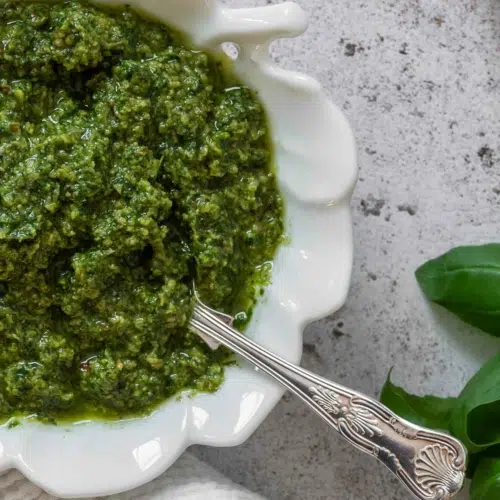
Homemade Pesto Without Pine Nuts (Easy Vegan Recipe)
Ingredients
- 40 g sunflower seeds (toasted*)
- 30 g cashew nuts (toasted*)
- 15 g flaked almonds (toasted*)
- 60 g fresh basil leaves
- 7 g nutritional yeast
- 50 ml olive oil (extra-virgin ideally)
- 3 small cloves garlic (minced (or 2 medium cloves))
- ¼ tsp dried rosemary
- 1/4-1/2 tsp salt
- ⅛ tsp ground black pepper
- up to 40 ml of water to loosen the mixture
Equipment
- Food Processor
Instructions
- Add all of the pesto ingredients to a food processor, starting with 1/4 tsp salt.Pulse until combined, scraping down the sides of the processor bowl as necessary before blending again. Add a little water as needed during the blending process to achieve the desired consistency for your pesto (thick for spreadable, thinner for a sauce).Taste and add more salt if desired.Note 1: If your sunflower seeds, cashew nuts and flaked almonds are not already toasted then add them to a dry (no oil) frying pan. Fry them over low heat, stirring occasionally, until lightly golden - this should take around 10 minutes.Note 2: Sunflower seeds can take a little longer to break down in the food processor than pine nuts do so make sure to blend for long enough to create a smooth sauce.40 g sunflower seeds, 60 g fresh basil leaves, 30 g cashew nuts, 15 g flaked almonds, 7 g nutritional yeast, 50 ml olive oil, 3 small cloves garlic, 1/4-1/2 tsp salt, 1/4 tsp dried rosemary, 1/8 tsp ground black pepper, up to 40 ml of water to loosen the mixture
- To store the pesto, add it to a Tupperware dish and cover it in eco cling film (with the film touching the top of the pesto) and then add an airtight lid. Alternatively, you can add a thin layer of olive oil on top of the pesto instead of using cling film, before adding an airtight lid.
- Store the pesto in the fridge, or freeze using an ice cube tray for single servings that you can use for a quick meal.

